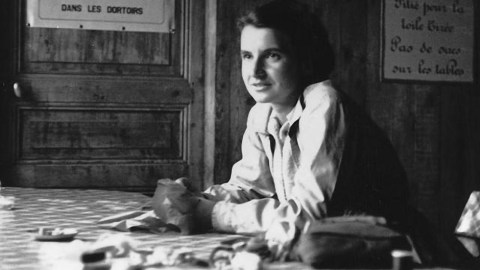2 Nobel Prizes: What Rosalind Franklin’s Work on DNA and Viruses Should Have Won

Big Think is proud to partner with the 92nd Street Y to bring you this series on female genius as part of its 7 Days of Genius Festival.
Rosalind Franklin is most known for her role in first capturing the blueprint for life. Her efforts provided the evidence to deduce the structure of DNA. Unfortunately, she’s also known as a scientist who has been cheated out of receiving due credit for her work. No one has lost out quite so famously as Franklin. Had she not died so young, at the age of 37, she would have likely shared in not one, but two Nobel Prizes.
Franklin’s genius showed early on. Her aunt Helen Bentwich, remarked to her husband: “Rosalind is alarmingly clever – she spends all her time doing arithmetic for pleasure, and invariably gets her sums right.” Her family would nurture her scholastic ability, sending her to St. Paul’s Girls’ School.
It was at Cambridge where she would learn about X-ray crystallography — a technique which reveals the atomic structure of matter in its crystalline form. Later on in her career, she would apply the techniques of X-ray diffraction to help her determine the structure of DNA.
Her dedication to the sciences was so great, her family accused her of making it her religion. She replied, “In my view, all that is necessary for faith is the belief that by doing our best we shall succeed in our aims: the improvement of mankind.”
At the time, many scientists had thought the structure of DNA had a structure similar to that of a corkscrew, but no one had the proof. A race was on to become the first to deduce the structure of DNA.
It would ultimately be Franklin, who led a research group at King’s College in London, that would first see DNA’s true design. She used X-ray diffraction to produce a fine beam of X-rays with exposures lasting for 100s of hours, refracting onto a piece of film. It was through these methods her team eventually produced the famous X-ray image, Photograph 51. The defraction image proved the DNA structure was indeed a double helix. However, this image wouldn’t stay secret for long. Maurice Wilkins, who had also been working on uncovering the structure of DNA at King’s College independent from Franklin, shared the legendary photo with James Watson without Franklin’s knowledge.

Up to this point, Watson and Crick had only been speculating on the structure of DNA–building models.By working off the data Franklin had patiently compiled over years at King’s college, Watson and Crick used her to lay claim to their own discovery. All the experimental work that led to their great leaps about how DNA replicates was brought to them through the efforts of Rosalind Franklin. It’s here we must ask, what would Watson and Crick have had without Franklin’s data?
Over 5 years ago, Big Think asked Watson what Franklin’s role was in the discovery of DNA. “She provided some crucial pieces of information,” he said. “I don’t think her name deserved to be on the paper; she fought bitterly saying it wasn’t a helix.” How he casts Franklin is less than flattering here and in his book The Double Helix, which was published after Franklin’s death back in 1968.
James Watson, Francis Crick, and Maurice Wilkins would ultimately share the 1962 Nobel Prize in Physiology or Medicine for their discovery of the double helix.
Before her death from ovarian cancer, Franklin also worked to look at the molecular structures of viruses at Birkbeck College, London. Once again, had she been alive, she would have likely shared in winning the Nobel Prize in Chemistry in 1982.
It’s uncertain if her pioneering work with X-rays contributed to her early death, however, we do know that science lost a great mind. One can only image what kind of advancements Franklin could have provided the world had she been given a lifetime to continue her work.
***
Photograph 51: PRaymond Gosling/King’s College London
Natalie has been writing professionally for about 6 years. After graduating from Ithaca College with a degree in Feature Writing, she snagged a job at PCMag.com where she had the opportunity to review all the latest consumer gadgets. Since then she has become a writer for hire, freelancing for various websites. In her spare time, you may find her riding her motorcycle, reading YA novels, hiking, or playing video games. Follow her on Twitter: @nat_schumaker





